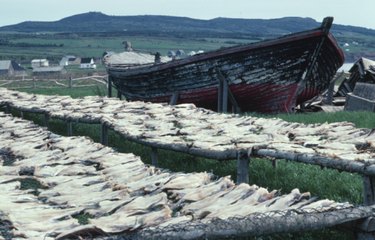Things You'll Need
3 plates, pans or other dishes
Shallow bowl
2 sheet pans
Wax paper or plastic wrap
Vinyl kitchen gloves (optional)
2 cups flour
1 cup milk
2 cups bread crumbs
6-8 oz. boneless cod fillets
Salt and pepper to taste
Skillet
Vegetable oil
Spatula
Brown craft paper

Cod has been one of North America's most important commercial fisheries for centuries, since the very earliest days of European exploration. Continental Europe had an insatiable appetite for fish thanks to the Church's numerous fasting days, when meat was not permitted. The New World's lavish stocks of cod, combined with its suitability for salting and drying, made it a cherished stable across the continent. Today most cod is purchased fresh or frozen, rather than dried, but it is still a popular and healthy food. Its firm texture and delicate flavor make it especially suited to pan-frying.
Preparation
Step 1
Set up a work surface from left to right with two plates, a shallow bowl and the third plate, in that order. Line a sheet pan with wax paper or plastic wrap, and place it on the right. Reverse the order of the setup if you are left handed.
Video of the Day
Step 2
Put on the kitchen gloves, if you will be using them. Fill the first plate with the cod fillets, and season them lightly with salt and pepper. Put the flour on the second plate, the milk in the bowl and the bread crumbs on the third plate.
Step 3
With your left hand dredge the first fillet through the flour, carefully coating both sides. Shake off any excess flour and dip the fillet into the bowl of milk. Finally, dredge the fillet in the bread crumbs, pressing firmly to ensure that both sides are coated.
Step 4
Transfer the coated fillet to the sheet pan with your right hand, which remains clean and dry. Repeat for the remaining fillets, topping up the flour, milk and crumbs as necessary.
Step 5
Place the fillets in the refrigerator for at least 15 minutes, or as long as two hours, so the coating has time to adhere to the fillets.
Frying
Step 1
Oil the skillet lightly and heat it to medium-hot. The frying temperature of the oil should be in the range of 380 to 400 degrees Fahrenheit, for best results.
Step 2
Fry the fillets two or three at a time, once the oil is hot. When the underside is golden brown, turn the fillets and cook for another two or three minutes. Extra-thick fillets will require slightly longer.
Step 3
Repeat with the remaining fillets once the skillet has returned to the correct temperature, adding more oil if necessary. The first batch of fillets may be kept warm on a paper-lined sheet pan, if desired. Preheat an oven to 200 degrees Fahrenheit to hold the initial batch of cod until the remainder are finished.
Step 4
Serve immediately, while the coating is fresh and crisp. The breading seals moisture into the fillets, keeping them juicy, but the steam from the hot cod will eventually soften the coating.
Tip
The cod may be cooked at low heat without breading, in olive oil or butter. This gives a more delicate result, and lends itself to the use of fresh herbs or sauces from the classic repertoire.
Warning
Fish is a common cause of food-borne illness. Buy only from reputable sources, and sanitize your utensils and work surfaces after they've been in contact with raw fish.
Video of the Day